Diego Marcon
Have You Checked the Children
27 Oct 2023 - 21 Jan 2024
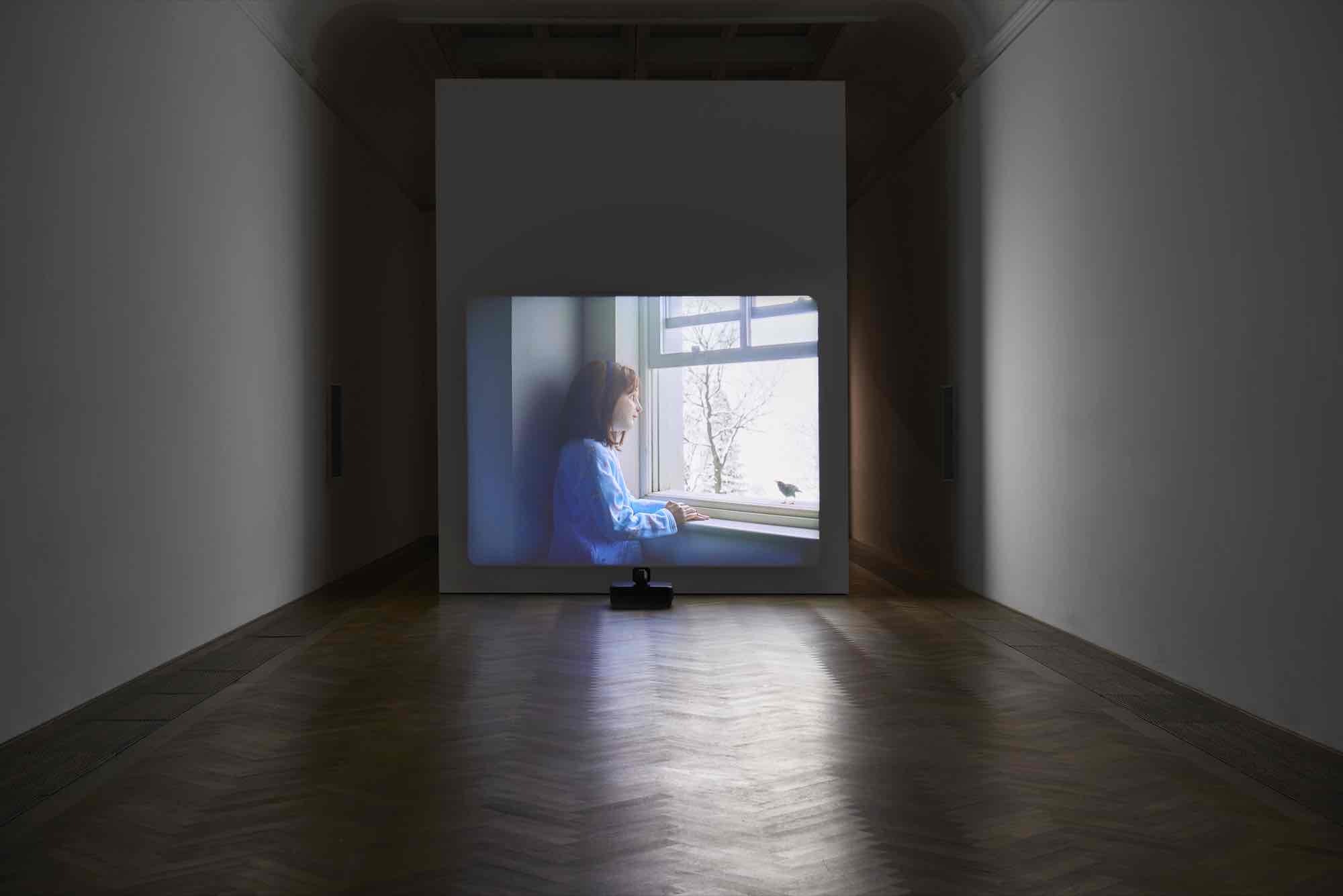
Diego Marcon, The Parents’ Room, 2021, installation view, in: Diego Marcon, Have You Checked the Children, Kunsthalle Basel, 2023, photo: Philipp Hänger / Kunsthalle Basel
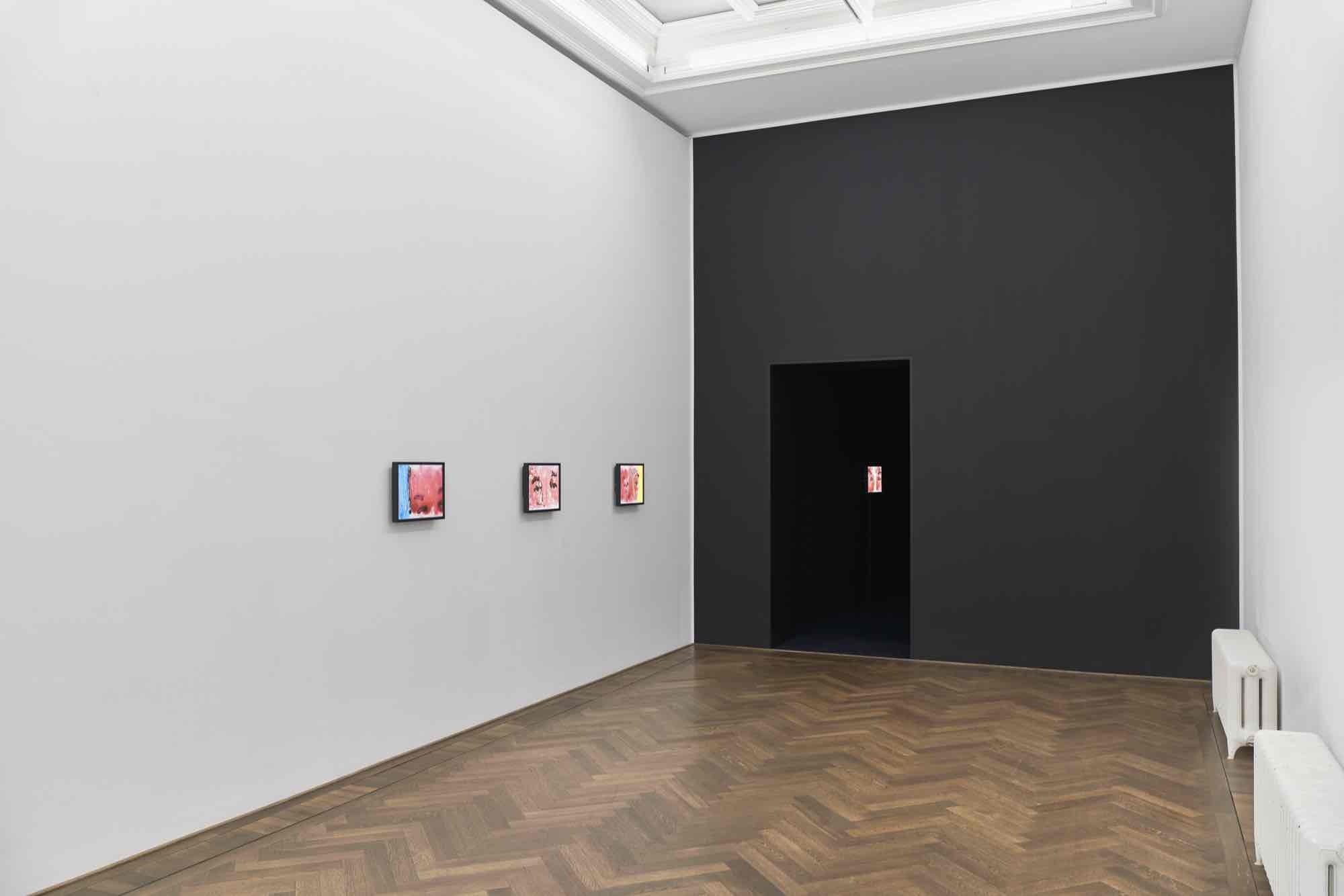
Diego Marcon, Have You Checked the Children, Kunsthalle Basel, 2023, exhibition view, photo: Philipp Hänger / Kunsthalle Basel
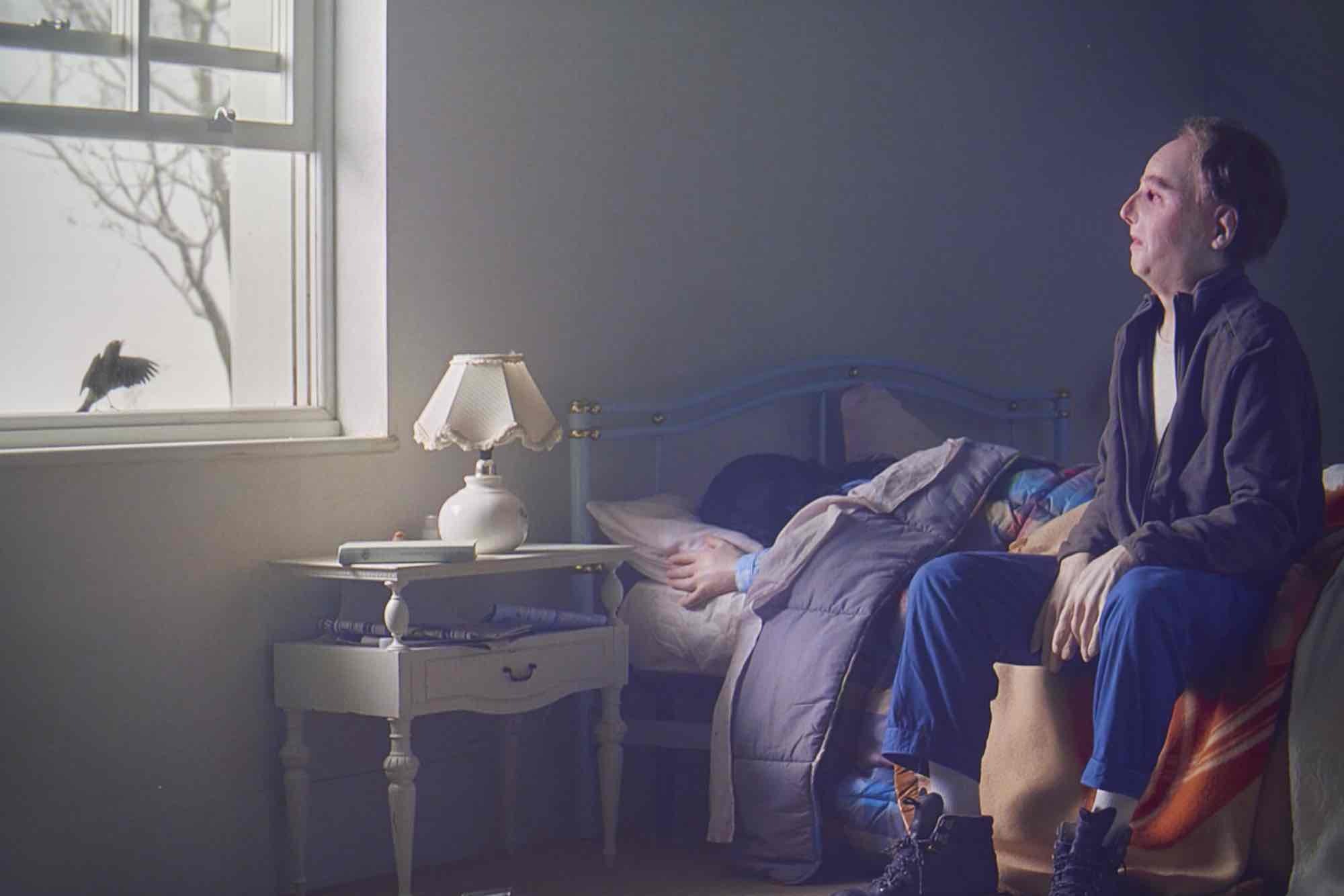
Diego Marcon, The Parents’ Room, 2021, detail view, in: Diego Marcon, Have You Checked the Children, Kunsthalle Basel, 2023, photo: Philipp Hänger / Kunsthalle Basel
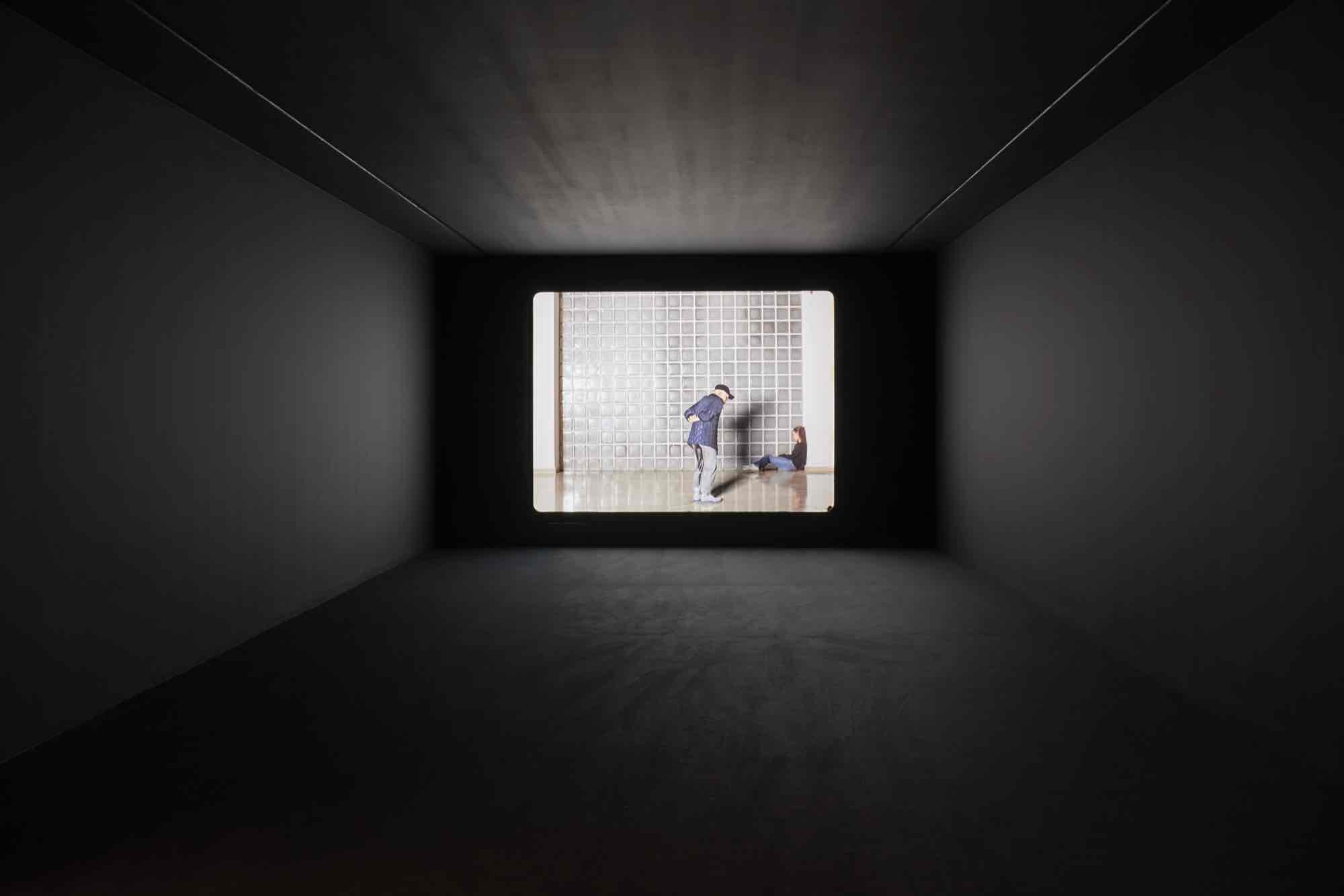
Diego Marcon, Monelle, 2017, installation view, in: Diego Marcon, Have You Checked the Children, Kunsthalle Basel, 2023, photo: Philipp Hänger / Kunsthalle Basel
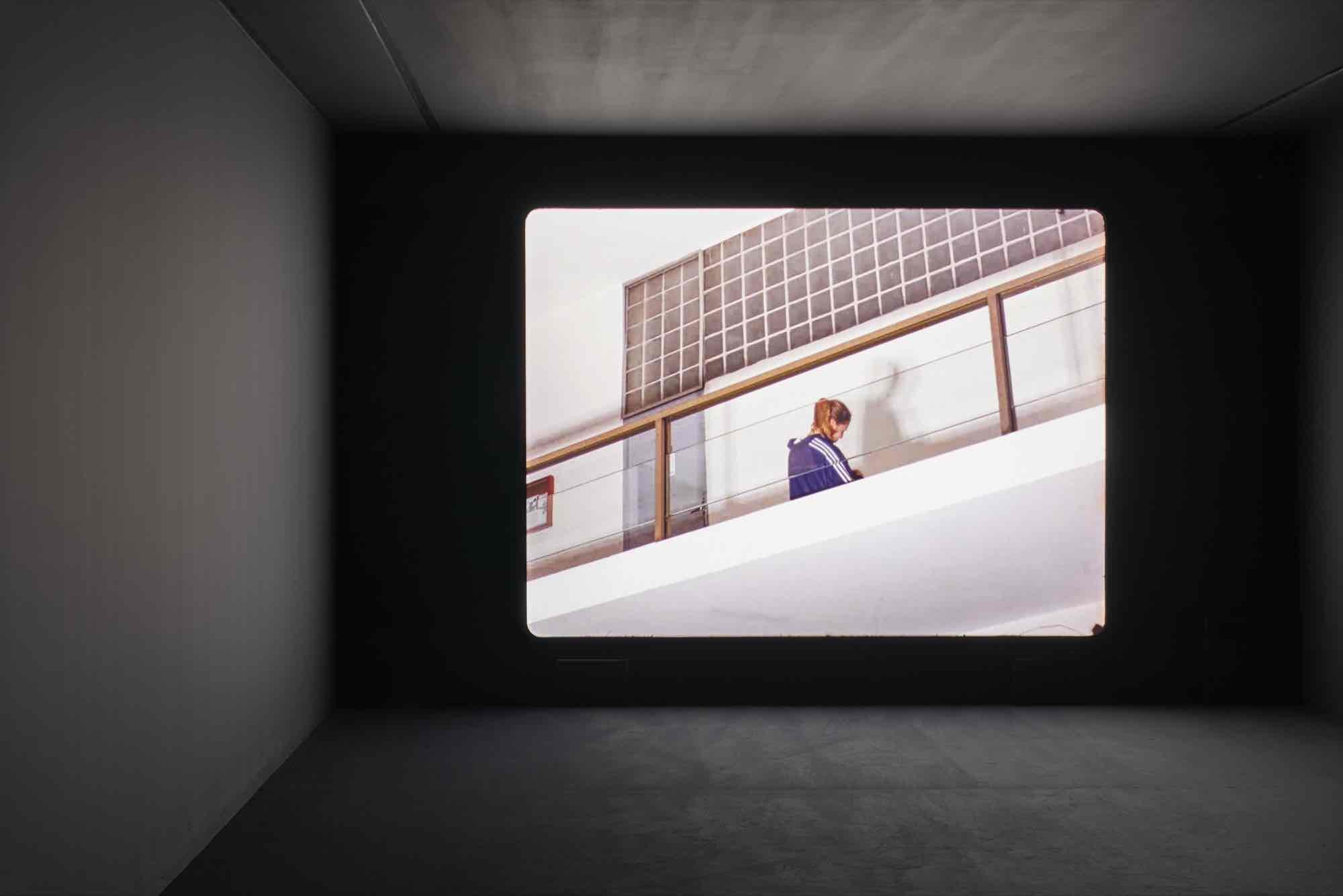
Diego Marcon, Monelle, 2017, installation view, in: Diego Marcon, Have You Checked the Children, Kunsthalle Basel, 2023, photo: Philipp Hänger / Kunsthalle Basel

Diego Marcon, La Banda di Crugnola, 2023, installation view, in: Diego Marcon, Have You Checked the Children, Kunsthalle Basel, 2023, photo: Philipp Hänger / Kunsthalle Basel
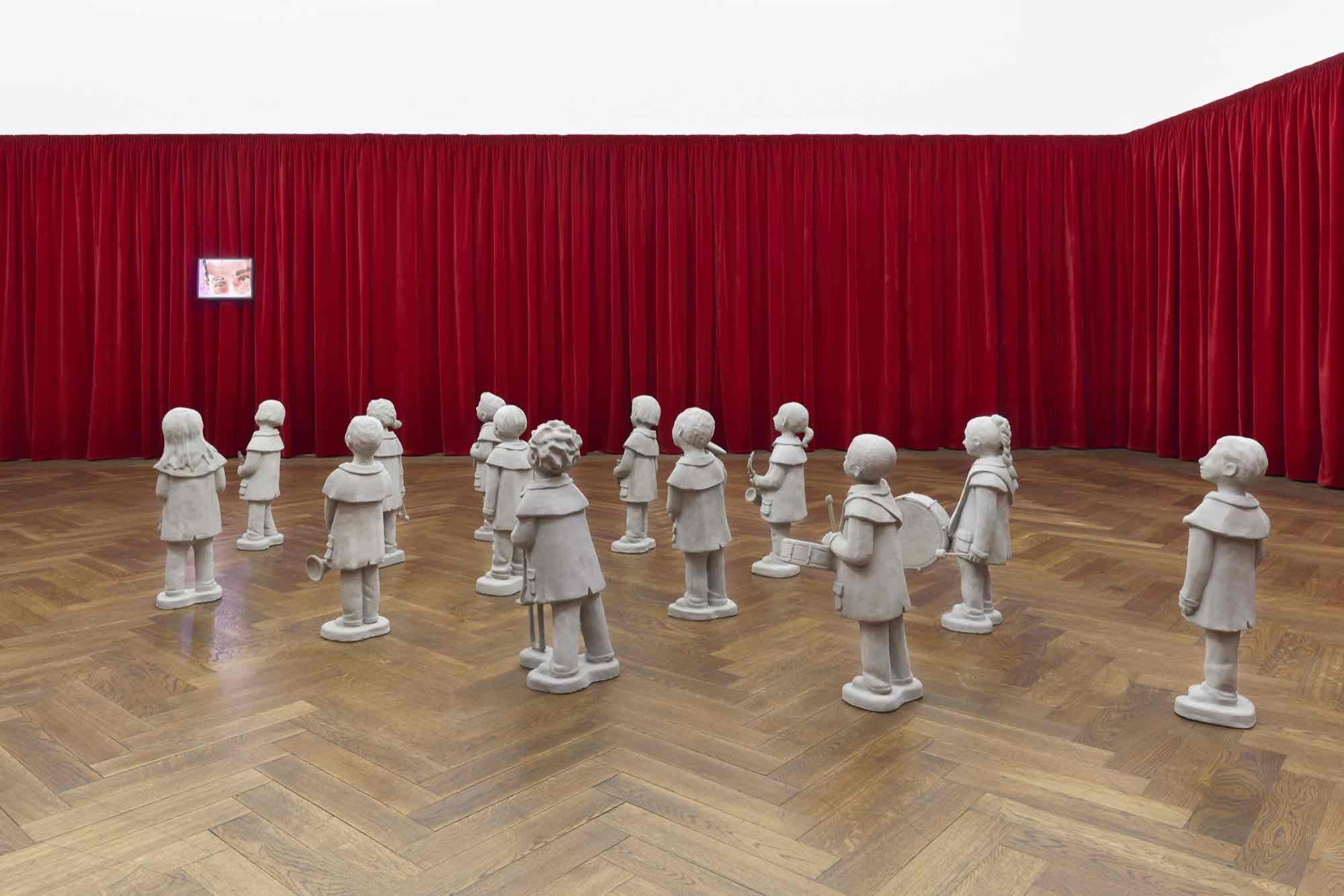
Diego Marcon, Have You Checked the Children, Kunsthalle Basel, 2023, exhibition view, photo: Philipp Hänger / Kunsthalle Basel

Diego Marcon, La Banda di Crugnola, 2023, detail view, in: Diego Marcon, Have You Checked the Children, Kunsthalle Basel, 2023, photo: Philipp Hänger / Kunsthalle Basel
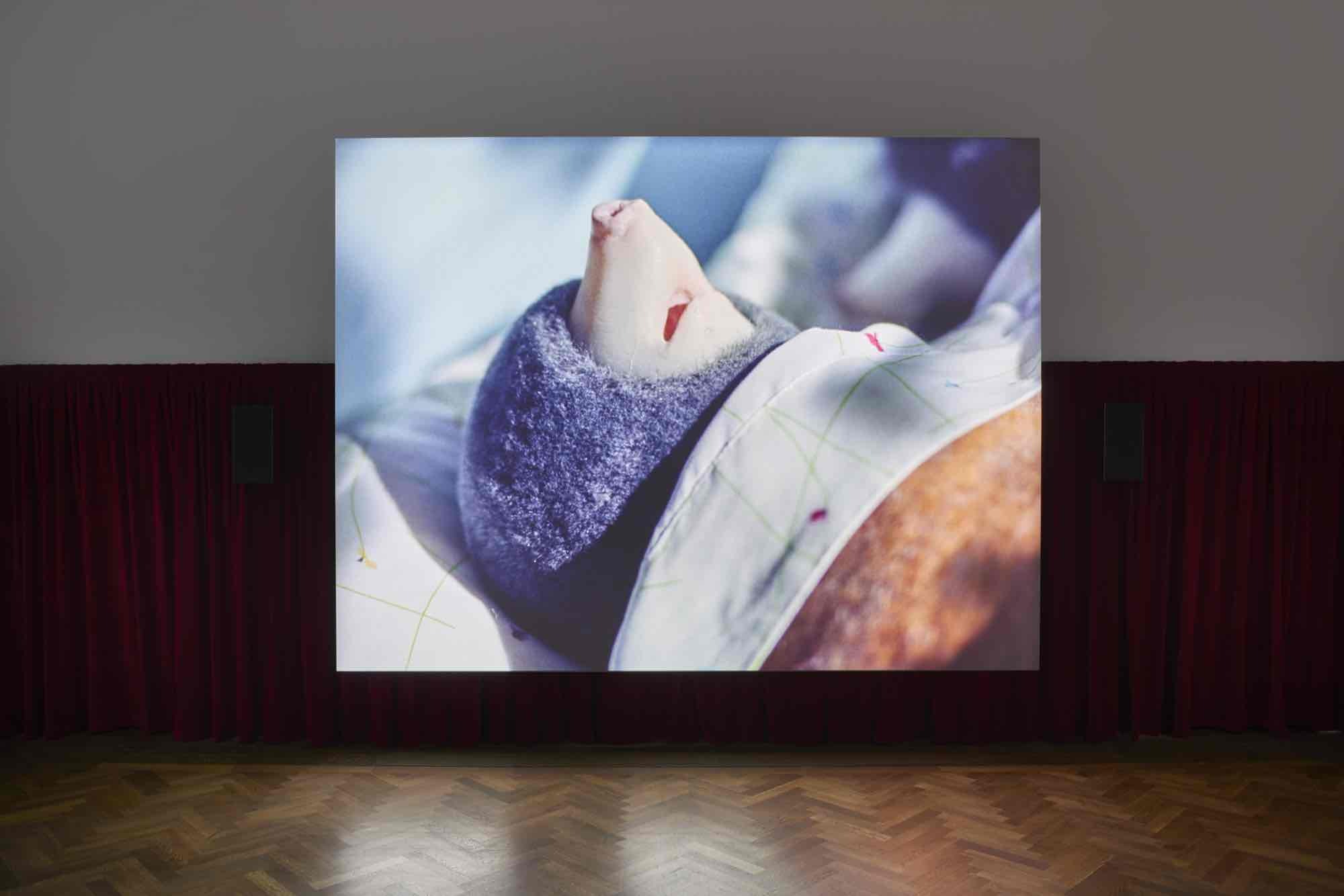
Diego Marcon, Dolle, 2023, detail view, in: Diego Marcon, Have You Checked the Children, Kunsthalle Basel, 2023, photo: Philipp Hänger / Kunsthalle Basel
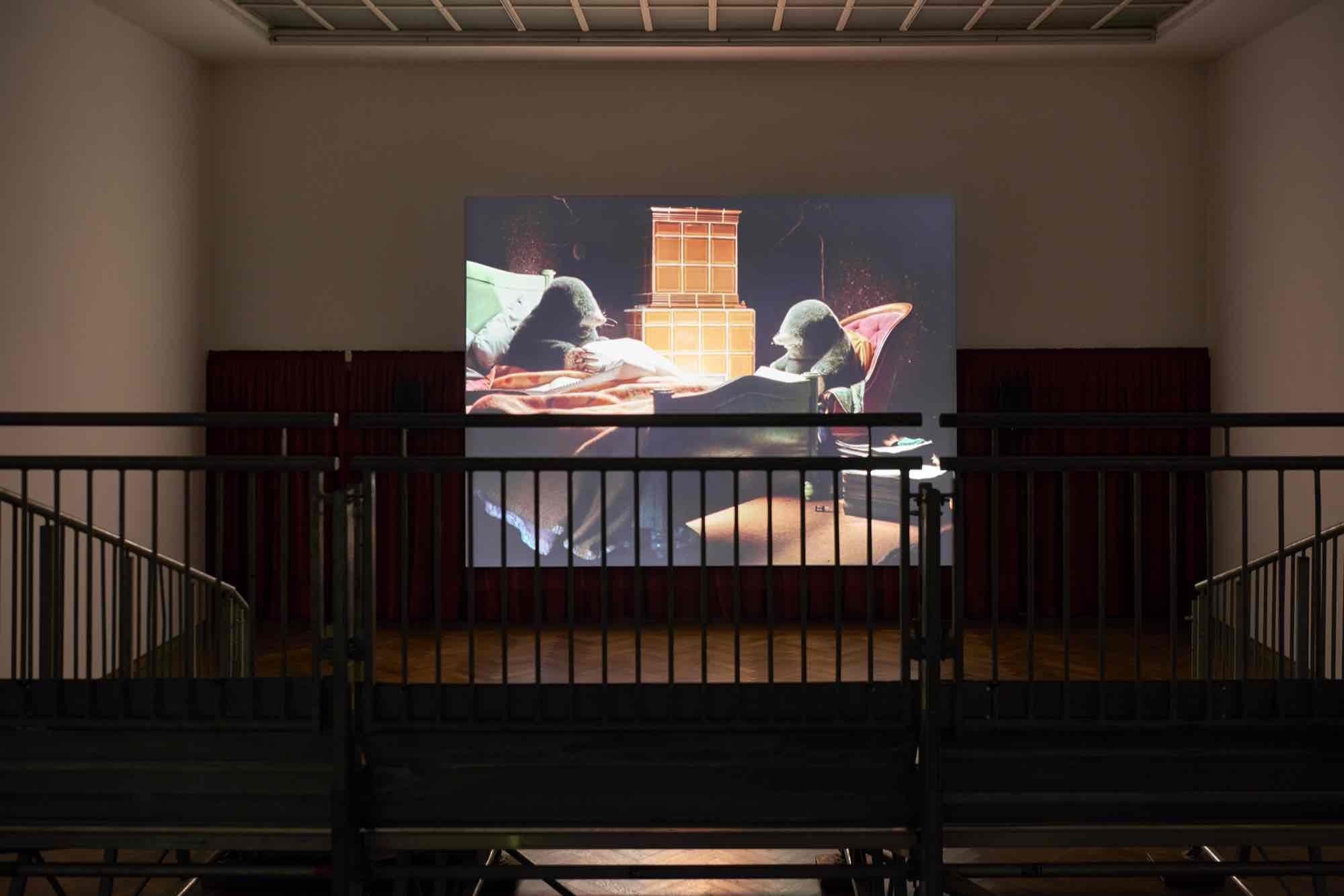
Diego Marcon, Dolle, 2023, installation view, in: Diego Marcon, Have You Checked the Children, Kunsthalle Basel, 2023, photo: Philipp Hänger / Kunsthalle Basel
As snow gently falls, a lone blackbird lands on the ledge of a bedroom’s open window. So far, so calm. Though not for long. Thus begins (and ends) Diego Marcon’s eerie, troubling, 35 mm film, The Parents’ Room (2021), which exemplifies much of the psychological and structural complexity that has become characteristic of Marcon’s art.
The snow is patently artificial, and the bird is computer generated (CGI), while the bedroom’s interior seems to be a carefully constructed stage set. Seated inside that crafted room, on the edge of a disheveled bed, a man operatically sings. He is real, an actor cast for the part, although his gummy face mask—a synthetic prosthetic of a visage—makes him look more corpse-like than living. This slippage is appro- priate, as he melodically, but with a strange coolness, tells of his domestic killing spree and subsequent suicide. It is the dead speaking. Well, singing. And then one by one, his two “dead” children (also real actors, also masked in similarly freaky face coverings) and their mother, who you realize has been lying beside her singing husband all along, proceed to unflinchingly recount their demise in song.
Theirs is a chilling, weirdly poignant horror story. At its center is an act—murder—as old as humanity itself. And, although we might not want to admit it, it’s perhaps as human, too. It is no coincidence, then, that Marcon—interested as he is in representing the messy underbelly of the human psyche—would understand that to tell the story of what it is to be mortal is to tell the story of death and, sometimes, even murder.
For the Italian artist’s first institutional solo exhibition in Switzerland, key works of the past few years can be seen together with his new film and a sculptural ensemble. Presented in specially conceived installations, the works deploy analog means alongside digital technologies to interrogate the fraught relationship between reality and representation. In so doing, the tension between power and vulnerability is often exposed—through-lines of Marcon’s wildly imaginative practice.
Composing the set, lighting, costume, sound, and script of each of his film projects with a small team of friends and collaborators, the artist flirts with different entertainment genres, such as the horror movie, slapstick comedy, Sunday morning television cartoon, and musical. Consistently, sound plays a key role. In some films, its absence speaks: silence becomes the protagonist, as much as in other films bursts of sound or specially commissioned music literally set the tone. The latter matters in particular because the artist sees music as “one of the most powerful tools to generate empathy within the spectator [and] to shape a very strong sentimental atmosphere.”
Silence, for instance, figures prominently in a series of 16 mm short films entitled, as an ensemble, Untitled (Head falling) (2015). Transferred to video, the multi-part work is shown on monitors dispersed across several rooms of the exhibition. These films’ childlike, animated quality carries visitors towards a darkened room where Marcon’s impressive, immersive Monelle (2017) is screened. The film, nearly fourteen minutes in duration, comprises a mere thirty individual shots, each lasting no more than a second, with the screen going black for extended intervals in between. The film centers on a group of adolescent girls inside the monolithic spaces of the Casa del Fascio in Como, Italy—a mod- ernist building designed as the headquarters of the regional Fascist Party under Benito Mussolini. The girls and their surroundings are visible only in momentary bursts of flashlight that last just long enough for the viewers’ gaze to register them. In the interim, a darkness that makes up most of the film engulfs the viewers. In the sharp, jarring flashes of imag- ery—each accompanied by a loud metallic pop—we spy the girls, languidly sleeping or dragging an older woman (is she dead?) through a building long dominated by the men that built, ran, and ruled it. Yet, around corners and near staircase balustrades, a second cast of menacing humanoids lurk. Human perception does not have enough time to register their CGI-generated artificiality; they materialize and disappear with a ghostly evanescence.
And with each successive burst of imagery and light, the afterimage of these, often hallucinatory, scenes lingers in the dark projection, burned onto the viewer’s retina. Set in dialogue with the building’s austerity, the figures’ vul- nerability and otherworldly presence conjure a disquieting atmosphere of terror and anxious- ness within a place that concretizes a history of power, oppression, and violence. In the fourth room of the exhibition, visitors continue to encounter a further of the animated falling heads, this one placed in front of the theatrical drapery that surrounds the room. The latter acts as a fitting backdrop for a concrete sculpture in thirteen parts, making up La Banda di Crugnola (2023), representing a miniaturized children’s marching band. Facing the viewer, the silent pack seems innocent enough in their stillness, but their gaze is defi- ant, questioning. The title refers to Crugnola, a small village in the North of Italy with a mod- est nearby train station. Since the station has such sparse traffic, the building is now used by the members of the local marching band to practice in the evenings. This story inspired Marcon, who connects a site of dying infra- structure with a petrified juvenile marching band sounding its death knell. The red velvet wall-covering continues into the last room, enframing the presentation of Dolle (2023), the artist’s most recent film. After pulling back the curtains, the first thing a visitor sees is a set of bleachers. Here, viewers watching the work themselves become the spectacle or something akin to a living sculpture as they sit in the stadium-like seating. One must pivot and turn to watch Dolle and itstwo furry protagonists—meticulously created robotic moles—as they huddle, wrapped in blankets and burrowed deep in a domesticized cave. Their only verbal exchange consists of pronouncing a sequence of numbers in an addition whose sum always comes out wrong. Their arithmetic feverishness is incessant—and utterly inexplicable. Dolle is, as the artist states, “a system—a film reduced to pure structure and language, with the language of the moles itself being nothing more than pure signs (num- bers, + and =).” For the artist, the film as a system takes on added sense when one realizes that the moles are, in fact, robots. The artist and his team had to laboriously engineer and program these animatronic beasts before creating the soundtrack and shooting the film. So instead of bringing a scripted plot to life as commonly done with actors, during Dolle’s shoot, the call for “Action!” entailed pressing “record” and capturing the preprogrammed robots performing.
The result loops and is deliberately constructed with no narrative arc, making it paradigmatic of much of Marcon’s work and perhaps even of the exhibition as a whole. To leave it is to have to go back the way you came—to enter a loop, in other words. Marcon is attentive to this, having structured his show in relation to the specificity of the institution’s ground floor spaces. On your way towards the last room—in which those two moles tally we-don’t-know-what—every work you pass, you will encounter again and view one more time as you leave. You emerge from the exhibition where you entered it, witnessing a CGI blackbird landing on a windowsill and a father singing of death. The exhibition’s title could be the first line in that work’s dark plot, in retrospect and thus paradoxically generating a sense of foreboding. Such feelings of ominous anticipation are typical of the horror movie genre, and in fact, the exhibition’s title echoes the repeated question of a murderer calling a babysitter in the 1977 horror movie, The Sitter. The mystery of why murdersuicide was apparently inevitable or what really happened in The Parents’ Room is never re- vealed. Nor is it meant to be. Because so it is in life. Marcon understands well that the theater of the human condition remains dark and elusive, and his work is just as recursive as is the human drama he trains his lens on. Until it starts all over again.
The snow is patently artificial, and the bird is computer generated (CGI), while the bedroom’s interior seems to be a carefully constructed stage set. Seated inside that crafted room, on the edge of a disheveled bed, a man operatically sings. He is real, an actor cast for the part, although his gummy face mask—a synthetic prosthetic of a visage—makes him look more corpse-like than living. This slippage is appro- priate, as he melodically, but with a strange coolness, tells of his domestic killing spree and subsequent suicide. It is the dead speaking. Well, singing. And then one by one, his two “dead” children (also real actors, also masked in similarly freaky face coverings) and their mother, who you realize has been lying beside her singing husband all along, proceed to unflinchingly recount their demise in song.
Theirs is a chilling, weirdly poignant horror story. At its center is an act—murder—as old as humanity itself. And, although we might not want to admit it, it’s perhaps as human, too. It is no coincidence, then, that Marcon—interested as he is in representing the messy underbelly of the human psyche—would understand that to tell the story of what it is to be mortal is to tell the story of death and, sometimes, even murder.
For the Italian artist’s first institutional solo exhibition in Switzerland, key works of the past few years can be seen together with his new film and a sculptural ensemble. Presented in specially conceived installations, the works deploy analog means alongside digital technologies to interrogate the fraught relationship between reality and representation. In so doing, the tension between power and vulnerability is often exposed—through-lines of Marcon’s wildly imaginative practice.
Composing the set, lighting, costume, sound, and script of each of his film projects with a small team of friends and collaborators, the artist flirts with different entertainment genres, such as the horror movie, slapstick comedy, Sunday morning television cartoon, and musical. Consistently, sound plays a key role. In some films, its absence speaks: silence becomes the protagonist, as much as in other films bursts of sound or specially commissioned music literally set the tone. The latter matters in particular because the artist sees music as “one of the most powerful tools to generate empathy within the spectator [and] to shape a very strong sentimental atmosphere.”
Silence, for instance, figures prominently in a series of 16 mm short films entitled, as an ensemble, Untitled (Head falling) (2015). Transferred to video, the multi-part work is shown on monitors dispersed across several rooms of the exhibition. These films’ childlike, animated quality carries visitors towards a darkened room where Marcon’s impressive, immersive Monelle (2017) is screened. The film, nearly fourteen minutes in duration, comprises a mere thirty individual shots, each lasting no more than a second, with the screen going black for extended intervals in between. The film centers on a group of adolescent girls inside the monolithic spaces of the Casa del Fascio in Como, Italy—a mod- ernist building designed as the headquarters of the regional Fascist Party under Benito Mussolini. The girls and their surroundings are visible only in momentary bursts of flashlight that last just long enough for the viewers’ gaze to register them. In the interim, a darkness that makes up most of the film engulfs the viewers. In the sharp, jarring flashes of imag- ery—each accompanied by a loud metallic pop—we spy the girls, languidly sleeping or dragging an older woman (is she dead?) through a building long dominated by the men that built, ran, and ruled it. Yet, around corners and near staircase balustrades, a second cast of menacing humanoids lurk. Human perception does not have enough time to register their CGI-generated artificiality; they materialize and disappear with a ghostly evanescence.
And with each successive burst of imagery and light, the afterimage of these, often hallucinatory, scenes lingers in the dark projection, burned onto the viewer’s retina. Set in dialogue with the building’s austerity, the figures’ vul- nerability and otherworldly presence conjure a disquieting atmosphere of terror and anxious- ness within a place that concretizes a history of power, oppression, and violence. In the fourth room of the exhibition, visitors continue to encounter a further of the animated falling heads, this one placed in front of the theatrical drapery that surrounds the room. The latter acts as a fitting backdrop for a concrete sculpture in thirteen parts, making up La Banda di Crugnola (2023), representing a miniaturized children’s marching band. Facing the viewer, the silent pack seems innocent enough in their stillness, but their gaze is defi- ant, questioning. The title refers to Crugnola, a small village in the North of Italy with a mod- est nearby train station. Since the station has such sparse traffic, the building is now used by the members of the local marching band to practice in the evenings. This story inspired Marcon, who connects a site of dying infra- structure with a petrified juvenile marching band sounding its death knell. The red velvet wall-covering continues into the last room, enframing the presentation of Dolle (2023), the artist’s most recent film. After pulling back the curtains, the first thing a visitor sees is a set of bleachers. Here, viewers watching the work themselves become the spectacle or something akin to a living sculpture as they sit in the stadium-like seating. One must pivot and turn to watch Dolle and itstwo furry protagonists—meticulously created robotic moles—as they huddle, wrapped in blankets and burrowed deep in a domesticized cave. Their only verbal exchange consists of pronouncing a sequence of numbers in an addition whose sum always comes out wrong. Their arithmetic feverishness is incessant—and utterly inexplicable. Dolle is, as the artist states, “a system—a film reduced to pure structure and language, with the language of the moles itself being nothing more than pure signs (num- bers, + and =).” For the artist, the film as a system takes on added sense when one realizes that the moles are, in fact, robots. The artist and his team had to laboriously engineer and program these animatronic beasts before creating the soundtrack and shooting the film. So instead of bringing a scripted plot to life as commonly done with actors, during Dolle’s shoot, the call for “Action!” entailed pressing “record” and capturing the preprogrammed robots performing.
The result loops and is deliberately constructed with no narrative arc, making it paradigmatic of much of Marcon’s work and perhaps even of the exhibition as a whole. To leave it is to have to go back the way you came—to enter a loop, in other words. Marcon is attentive to this, having structured his show in relation to the specificity of the institution’s ground floor spaces. On your way towards the last room—in which those two moles tally we-don’t-know-what—every work you pass, you will encounter again and view one more time as you leave. You emerge from the exhibition where you entered it, witnessing a CGI blackbird landing on a windowsill and a father singing of death. The exhibition’s title could be the first line in that work’s dark plot, in retrospect and thus paradoxically generating a sense of foreboding. Such feelings of ominous anticipation are typical of the horror movie genre, and in fact, the exhibition’s title echoes the repeated question of a murderer calling a babysitter in the 1977 horror movie, The Sitter. The mystery of why murdersuicide was apparently inevitable or what really happened in The Parents’ Room is never re- vealed. Nor is it meant to be. Because so it is in life. Marcon understands well that the theater of the human condition remains dark and elusive, and his work is just as recursive as is the human drama he trains his lens on. Until it starts all over again.
